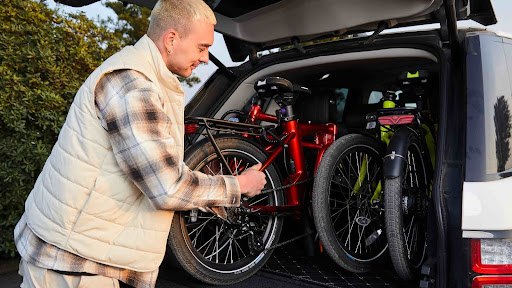Selecting the first electric bike for adults is a significant decision for several reasons. A well-chosen e-bike will align with your specific needs, making a significant difference whether you’re commuting, enjoying recreational rides, or carrying heavy loads.
The right e-bike ensures comfort, safety, and efficiency, enhancing your overall riding experience. Additionally, it will offer long-term value by saving you money on transportation, reducing your carbon footprint, and promoting a healthier lifestyle.
Therefore, this guide aims to walk you through the essential aspects of how to choose an e bike, ensuring you make an informed and satisfying choice.
Understanding E-Bike Types
Electric bikes come in a variety of styles and types, each tailored for specific terrains and riding conditions. To choose the right e-bike for your needs, consider where you’ll primarily be riding and how the bike will fit your lifestyle and preferences.
Now, let’s get into the details:
Commuter E-Bikes
Commuter e-bikes are designed for daily travel, whether you’re commuting to work, getting around town, or enjoying some exercise without overexertion.
They typically feature lightweight frames, efficient motors, and long-range batteries designed for daily commutes. Additional features like lights, fenders, and racks enhance their practicality for city riding.
With a focus on efficiency and comfort, commuter e-bikes are an excellent choice for those looking to replace their car or public transportation for daily commutes.
Mountain E-Bikes
Mountain e-bikes are designed for off-road adventures and rugged terrains, offering a perfect blend of power and fun.
Positioned low and centrally on the bike, the motor and battery provide enhanced stability and control, making these e-bikes ideal for exploring nature and tackling challenging trails.
With wide, knobby tires for improved traction and durability, mountain e-bikes enable you to go farther and faster with less effort than a traditional bicycle. They provide the necessary power and support to conquer hills and uneven paths, making outdoor adventures more accessible and enjoyable.
Cargo E-Bikes
Cargo e-bikes are built to carry heavy loads, making them perfect for errands, deliveries, or transporting children. With sturdy frames, extended cargo areas, and powerful motors, they can easily handle extra weight.
Often equipped with customizable options like racks, baskets, and child seats, cargo e-bikes provide a practical solution for those needing to transport goods without relying on a car.
They offer a sustainable and cost-effective alternative for short-distance haulage, making daily tasks more efficient and environmentally friendly.
Key Features to Consider
Motor Types and Power
One of the most essential components of an electric bicycle is its motor, and understanding its types and power ratings is crucial.
Hub motors are located on either the front or rear wheel. They are generally quieter and require less maintenance compared to other types, providing a smooth and straightforward riding experience ideal for flat terrains and urban commuting. Hub motors come in two varieties:
- Direct Drive Motors: These offer less resistance and are ideal for high-speed travel, making them perfect for commuting.
- Geared Hub Motors: These provide better torque, which is beneficial for hill climbing and more varied terrains.
- Mid-drive motors: These are positioned at the bike’s crankset, allowing for better weight distribution and improved handling. They are particularly effective for hilly terrains and off-road biking due to their superior torque and efficiency.
Mid-drive motors work harmoniously with the bike’s gears, offering a more natural riding feel and better performance on steep inclines and challenging terrains.
Battery Capacity and Range
Battery capacity and range are critical factors that affect the performance and usability of an e-bike. The battery produces the power that propels you beyond your natural momentum. To ensure your e-bike meets your needs, consider how far you plan to ride on a single charge and select a bike with a suitable battery.
There are three popular types of batteries found in ebikes:
- Lithium-Ion Batteries: These are the most common due to their high energy density and long lifespan. They offer the best balance of weight, capacity, and longevity, making them the preferred choice for most e-bikes.
- Lead-Acid Batteries: More economical but heavier and sensitive to climate variations. These are less common in modern e-bikes due to their bulk and lower efficiency.
- Nickel-Cadmium Batteries: Lighter than lead-acid batteries but slower to charge and prone to performance-impacting defects. These are also becoming less common due to their drawbacks.
Factors Affecting Range
The range of an electric bike is the maximum distance it can travel on a fully charged battery. The average range of most ebikes is somewhere between 20 and 50 miles, but this can vary widely based on several factors:
- Battery Capacity: Measured in watt-hours (Wh), this indicates the total energy stored. Higher Wh translates to longer range.
- Motor Power and Efficiency: A powerful motor will drain the battery faster, while an efficient motor will maximize range.
- Terrain and Speed: Hilly terrain and higher speeds require more power, reducing range. Conversely, flat roads and moderate speeds use less energy.
- Rider Weight and Cargo: Heavier loads put more strain on the motor, decreasing range.
- Weather Conditions: Extreme cold or heat can reduce battery performance and range.
- Riding Style: Frequent starting, stopping, and acceleration consume more energy compared to a steady pace.
Frame Material and Design
The frame material and design of an e-bike significantly influence its durability, weight, and comfort. So, when choosing between two comparable bikes, consider which model best suits your specific needs and riding style.
Aluminum vs. Steel Frames
Aluminum frames are lightweight and resistant to rust, making them a popular choice for many ebikes for sale. They offer a good balance of strength and weight, ideal for both commuting and recreational riding. Aluminum frames are also generally more affordable and provide a stiffer ride, which can be beneficial for efficient power transfer.
Steel frames, on the other hand, are heavier but more durable and provide a smoother ride due to their flexibility. This material is less common in modern e-bikes but is favored by some riders for its robustness and ability to absorb road vibrations, offering a more comfortable ride over rough surfaces.
Step-Through vs. Traditional Frames
Featuring a low top tube, step-through frames make it easier to mount and dismount the bike. This design is particularly beneficial for riders with mobility issues or those who frequently ride in stop-and-go traffic. Step-through frames are also convenient for riders wearing skirts or dresses and offer greater ease of use in urban settings.
Traditional frames, with a higher top tube, offer more rigidity and a classic look. They are preferred for their increased structural integrity and are often chosen by riders who prioritize performance and a traditional cycling posture.
Assessing Your Needs
Commuting Requirements
If you intend to use your e-bike for daily commutes, prioritize factors such as range, portability, weatherproofing, and lightweight ebike. Consider your route and any specific needs, like storage for work essentials.
Look for a compact electric bike with a reliable motor, decent battery range, and practical features like lights and fenders. The Leoguar Flippo folding electric bike, for instance, folds compactly for easy storage on public transport or at the office. Its lightweight build makes carrying it upstairs or up short hills a breeze.
Recreational Riding
For leisurely rides, prioritize comfort and versatility. Choose an e-bike that matches your preferred type of recreation, whether it’s paved trails, gravel paths, or mountain terrain.
Opt for mountain e-bikes with sturdy frames and suspension systems for off-road adventures, or consider comfortable commuter or hybrid e-bikes for casual neighborhood rides.
Budget Considerations
E-bikes can vary significantly in price, from a few hundred to several thousand dollars depending on features, technology, and brand. Set a budget that aligns with your financial situation and needs.
While cheaper e-bikes may save money upfront, they lack essential features or durability. Conversely, higher-end models offer better performance, longer battery life, and enhanced features, albeit at a higher cost. Consider investing more upfront for better long-term performance, range, and reliability.
Conclusion
So, you’re ready to dive into the exciting world of e-biking! By now, you should be equipped with the knowledge to choose the perfect electric companion for your two-wheeled adventures.
Remember, the most important factor is to find an e-bike that aligns with your needs and riding style. Don’t hesitate to take several bikes for a spin before making your final decision.
So, what are you waiting for? Get out there, experience the thrill of e-biking, and discover the joy of the open road ahead.



